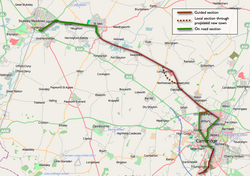Some of you will know that I have just started to intern with Cllr Tim Kent in Bristol, and working with him on the proposed new public transport scheme for Bristol. As a train nut, the idea of more buses than trains didn't appeal to me until I got to grips with what this could actually mean.
Naturally, when it comes to the issue of public transport, those elsewhere in Europe are miles ahead of us. In this case, the Germans have been there, done that, and tested all the options several decades before us, as demonstrated here in Essen. The link also highlights the successes of KGBs.
The Bristol bids focus on the following routes:
1) Long Ashton to Temple Meads and the Centre
2) Hengrove to the North Fringe
3) Long Ashton to Hengrove
More details can be found here (Images wouldn't copy over clearly to this blog post)
What I am going to talk about now is the possibility KGBs raise, not just in terms of Bristol, but nationwide.
Having looked at Bus Rapid Transit Schemes around the UK and around the world, I have learnt a few things:
1) These buses can go on existing roads, and on purpose built roads
2) KGB exclusive roads create an added bonus of extra speed and freedom from other forms of traffic
3) Like trams, trains and london transport, ticket buying before boarding reduces the amount of time the buses need to be stationary and therefore decreases the travel time for commuters.
What this means is that unlike a train or a tram, or indeed a normal bus, these buses are the most flexible type of public transport vehicle, and have the potential to revolutionise public transport today, and here's why.
1) Re-opening parts of former rail lines, and rebuilding the track as was (in areas where there aren't any single track cycle paths), is in most cases impossible simply because the ground has been built on in parts, turned into roads, or has been leveled to match the surrounding landscape so that farmers owning the land can maximise their use of it.
3) Buses can go up and down steeper gradients with greater ease than trams or trains.
4) Former rail lines can be used IN CONJUCTION with existing roads to create rapid transit routes that facilitate demand and reduce the use of cars.
5) As KGB legislation requires a maintenance lane (just like the channel tunnel has a maintenance tunnel), this lane can be used as cycle path when no work on the route is required, increasing the number of cycle routes.
Some of you may think that I am talking out of fantasy here, but let me prove you wrong.

Cambridgeshire, hosts the longest KGB route in the world! It opened earlier this month and it runs from St Ives to Cambridge. It utilises the former St Ives to Cambridge train line as well as existing roads. It also provides a route cyclists and horse riders on its maintenance track that runs down one side. To ensure that prices stay reasonable, three different routes with competing companies use the KGB-only section along the former train line. Details about how exactly it works can be found here.
Now it wasn't all a raving party for the KGB over in Cambridgeshire, and as a transport enthusiast myself, I can speak with confidence that there is as much unity on which direction the country should take regarding the future of transportation, as there is with the unity on the topic of the EU amongst Tories, (ie none whatsoever). Therefore unsurprisingly the groups CAST IRON and www.noguidedbus.com focusing on the issues of cost and a lack of a direct link between the East Coast Main Line and Stansted Airport, without the need to go through London first. They focused on re-opening the railway between Huntingdon and Cambridge via St Ives highlighting the success of the Wensleydale Railway.
However,
1) the Cambridgeshire KGB has covered more the distance between Cambridge and Huntingdon, than the Wensleydale line has between its two main North-South railway lines
2) There are route connecting the two stations via the Bus Guideway
3) The Wensleydale line took 8 years to be constructed and running services on its current route, compared to the Cambridgeshire KGB taking just 4 years.
4) The line between St Ives and Huntingdon has had the last mile or so built on with buildings and the A14, requiring land to be purchased and work required to simply create a bed for the track to exist on before one could be laid, however buses can utilise existing roads to connect Huntingdon and St Ives.
5) Bus companies were overwhelmed with the amount of passenger journeys made on it during its first week, and had to lay on extra buses to cope with demand.
In many cases, bendy buses are used. This offers 3 entrances/exits instead of 1 or 2, therefore making it easier and quicker to board/alight the bus. They also have 50% extra seating than double decker route-master buses. Also passengers must buy tickets before boarding, meaning stingy buggers like me don't spend three minutes counting out the pennies in front of the bus driver to prove we have the right amount of money for the fare, and don't hold up everyone else on board.
All in all, KGBs are faster, safer (as they have their own routes), greener (as the reduce the number of cars on the road), and provide a better usage of land (as in the case of former Beeching lines, create two tracks PLUS a cycle/bridle path).
Quite frankly, it would be foolish to say no.

